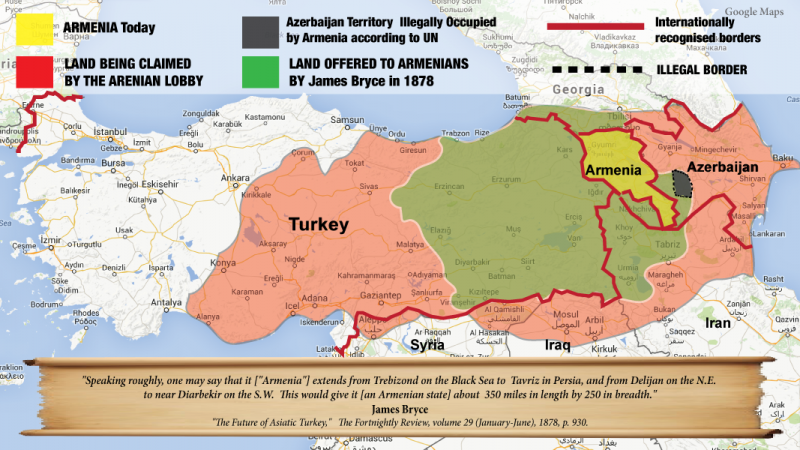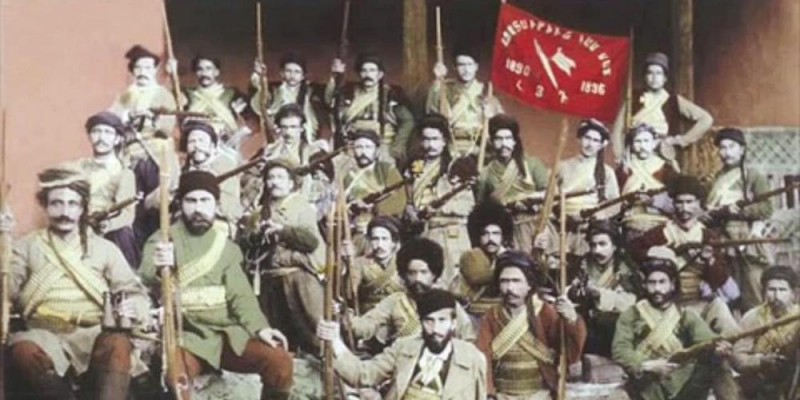Ottoman Armenians – The Most Loyal Nation
The establishment and expansion of the Ottoman Empire, and in particular the destruction of Byzantium following Fatih Mehmed’s conquest of Istanbul in 1453 opened a new era of religious, political, social, economic and cultural prosperity for the Armenians as well as the other non-Muslim and Muslim peoples of the new state. The very first Ottoman ruler, Osman Bey (1300-1326), permitted the Armenians to establish their first religious center in western Anatolia, at Kutahya, to protect them from Byzantine oppression. This center subsequently was moved, along with the Ottoman capital, first to Bursa in 1326 and then to Istanbul in 1461, with Fatih Mehmet issuing a ferman definitively establishing the Armenian Patriarchate there under Patriarch Hovakim and his successors.4 As a result, thousands of Armenians emigrated to Istanbul from Iran, the Caucasus, eastern and central Anatolia, the Balkans and the Crimea, not because of force or persecution, but because the great Ottoman conqueror had made his empire into a true center of Armenian life. The Armenian community and church thus expanded and prospered as parts of the expansion and prosperity of the Ottoman Empire.
The Gregorian Armenians of the Ottoman Empire, like the other major religious groups, were organized into millet communities under their own religious leaders. Thus the ferman issued by Fatih Mehmet establishing the Armenian Patriarchate of Istanbul specified that the Patriarch was not only the religious leader of the Armenians, but also their secular leader. The Armenians had the same rights as Muslims, but they also had certain special privileges, most important among which was exemption from military service. Armenians and other non-Muslims generally paid the same taxes as Muslims, with the exception of the Poll Tax (Harach or Jizye), which was imposed on them in place of the state taxes based particularly on Muslim religious law, the Alms Tax (Zakat) and the Tithe (Oshur), from which non-Muslims were exempted. The Armenian millet religious leaders themselves assessed and collected the Poll Taxes from their followers and turned the collections over to the Treasury officials of the state.
The Armenians were allowed to establish religious foundations to provide financial support for their religious, cultural, educational and charity activities, and when needed the Ottoman state treasury gave additional financial assistance to the Armenian institutions which carried out these activities as well as to the Armenian Patriarchate itself. These Armenian foundations remain in operation to the present day in the Turkish Republic, providing substantial financial support to the operations of the Armenian church.
By Ottoman law all Christian subjects who were not Greek Orthodox were included in the Armenian Gregorian millet. Thus the Paulicians and Yakubites in Anatolia as well as the Bogomils and Gypsies in the Balkans were counted as Armenians, leading to substantial disputes in later times as to the total number of Armenians actually living in the Empire.
The Armenian community expanded and prospered as a result of the freedom granted by the sultans. At the same time Armenians shared, and contributed to, the Turkish-Ottoman culture and ways of life and government to such an extent that they earned the particular trust and confidence of the sultans over the centuries, gaining the attribute “the loyal millet”. Ottoman Armenians became extremely wealthy bankers, merchants, and industrialists, while many at the same time rose to high positions in governmental service. In the 19th century, for example, twenty-nine Armenians achieved the highest governmental rank of Pasha. There were twenty-two Armenian ministers, including the Ministers of Foreign Affairs, Finance, Trade and Post, with other Armenians making major contributions to the departments concerned with agriculture, economic development, and the census. There also were thirty-three Armenian representatives appointed and elected to the Parliaments formed after 1826, seven ambassadors, eleven consul-generals and consuls, eleven university professors, and forty- one other officials of high rank.
Over the centuries Armenians also made major contributions to Ottoman Turkish art, culture and music, producing many artists of first rank who are objects of praise and sources of pride for Turks as well as Armenians in Turkey. The first Armenian printing press was established in the Ottoman Empire in the 16th century.
Thus the Armenians and Turks, and all the various races of the Empire lived in peace and mutual trust over the centuries, with no serious complaints being made against the Ottoman system or administration which made such a situation possible. It is true that,
from time to time, internal difficulties did arise within some of the individual millets. Within the Armenian millet disputes arose over the election of the patriarch between the “native” Armenians, who had come to Istanbul from Anatolia and the Crimea, and those called “eastern” or “foreign” Armenians, who came from Iran and the Caucasus. These groups often complained against each other to the Ottomans, trying to gain governmental support for their own candidates and interests, and at the same time complaining about the Ottomans whenever the decisions went against them, despite the long-standing Ottoman insistence on maintaining strict neutrality between the groups. The gradual triumph of the “easterners” led to the appointment of non-religious individuals as Patriarchs, to corruption and misrule within the Armenian millet, and to bloody clashes among conflicting political groups, against which the Ottomans were forced to intervene to prevent the Armenians from annihilating each other.
These internal disputes, as well as the general decline of religious standards within the Gregorian millet led many Armenians to accept the teachings of foreign Catholic and Protestant missionaries sent into the Empire during the 19th century, causing the creation of separate millets for them later in the century. The Armenian Gregorian leaders asked the Ottoman government to intervene and prevent such conversions, but the Ottomans refrained from doing so on the grounds that it was an internal problem which had to be dealt with by the millet and not the state. Bloody clashes followed, with the Gregorian patriarchs Chuhajian and Tahtajian going so far to excommunicate and banish all Armenian protestants.6 Later on, serious clashes also emerged among the Armenian Catholics as to the nature of their relationship with the Pope, with the latter excommunicating all those who did not accept his supremacy, forcing the Ottomans finally to intervene and reconcile the two Catholic groups in 1888.
The freedom granted and the great tolerance shown by the Ottomans to non- Muslims was so well known throughout Europe that the empire of the sultans became a major place of refuge for those fleeing from religious and political persecution. Starting with the thousands of Jews who fled from persecution in Spain following its re-conquest in 1492, Jews fled to the Ottoman Empire from the regular pogroms to which they were subjected in Central and East Europe and Russia. Catholics and Protestants likewise fled to the Ottoman Empire, often entering the service of the sultans and making major contributions to Ottoman military and governmental life. Many of the political refugees from the reaction that followed the 1848 revolutions in Europe also fled for protection to the Ottoman Empire.
The claims that the Ottomans misruled non-Muslims in general and the Armenians in particular thus are disproved by history, as attested by major western historians, from the Armenians Asoghik and Mathias to Voltaire, Lamartine, Claude Farrere, Pierre Loti, Nogueres Hone Caetani, Philip Marshall Brown, Michelet, Sir Charles Wilson, Politis, Arnold, Bronsart, Roux, Grousset Edgar Granville Garnier, Toynbee, Bernard Lewis, Shaw, Price, Lewis Thomas, Bombaci and others, some of whom could certainly not be labeled as pro-Turkish. To cite but a few of them:
Voltaire:
“The great Turk is governing in peace twenty nations from different religions. Turks have taught to Christians how to be moderate in peace and gentle in victory.”
Philip Marshall Brown:
“Despite the great victory they won, Turks have generously granted to the people in the conquered regions the right to administer themselves according to their own rules and traditions.”
Politis who was the Foreign Minister in the Greek Government led by Prime Minister Venizelos:
“The rights and interests of the Greeks in Turkey could not be better protected by any other power but the Turks.”
J. W. Arnold:
“It is an undeniable historic fact that the Turkish armies have never interfered in the religious and cultural affairs in the areas they conquered.”
German General Bronsart:
“Unless they are forced, Turks are the world’s most tolerant people towards those of other religions’.”
Even when Napoleon Bonaparte sought to stir a revolt among the Armenian Catholics of Palestine and Syria to support his invasion in 1798-1799, his Ambassador in Istanbul General Sebastiani replied that
“The Armenians are so content with their lives here that this is impossible.”



